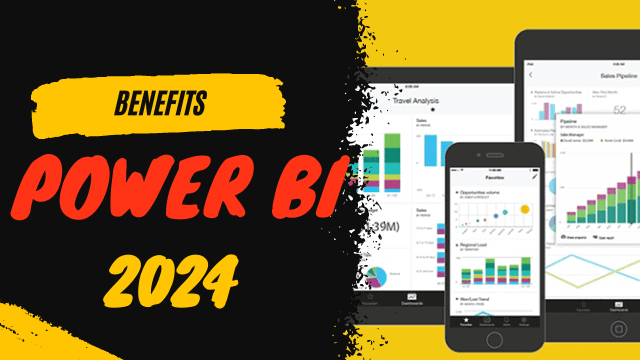Undeniable Benefits Of Power BI That You Should Know In 2024
Key Benefits of Power BI
Running a company requires constant decision-making. The company’s leader lacks the necessary control over a decision and does it as best as they can, or even by mistake.
The benefits of Power BI are numerous, and it aids management teams in making fast decisions without jeopardizing the company’s profitability. Data visualization is made simple with Power BI. It has a full summary of company data in visual form, with display choices such as tables, charts, gauges, and maps. This makes it easier for teams to use.
Power BI helps companies be more efficient, agile, and flexible by making it easy to see results. Power BI is a powerful business intelligence and data visualization tool developed by Microsoft. It offers a range of benefits that make it popular for data analysis and reporting:
- Data Visualization: Power BI enables you to create compelling visualizations, charts, graphs, and dashboards from your data. These visuals are interactive and provide insights that are easy to understand, making it simpler to communicate complex information.
- Data Connectivity: Power BI allows you to connect to a wide variety of data sources, including databases, cloud services, spreadsheets, and APIs. This flexibility enables you to bring together data from different sources for comprehensive analysis.
- Real-Time Dashboards: With Power BI’s real-time capabilities, you can create live dashboards that display data updates as they happen. This is especially valuable for tracking key performance indicators and making data-driven decisions in real time.
- Data Transformation: Power Query, a component of Power BI, offers data transformation capabilities, allowing you to clean, reshape, and combine data from multiple sources before analysis. This helps ensure data accuracy and quality.
- Natural Language Queries: Power BI supports natural language queries, allowing users to ask questions about their data using everyday language. This feature makes data exploration more intuitive and accessible to users who may not have technical expertise.
- Data Modeling: The Power BI data modeling engine lets you create relationships between different data tables, define calculations, and create measures. This enables you to perform advanced calculations and build complex data models for in-depth analysis.
- Collaboration and Sharing: Power BI facilitates collaboration by allowing users to share reports and dashboards with colleagues and stakeholders. Reports can be published to the Power BI service or embedded in other applications, promoting information sharing.
- Mobile Accessibility: Power BI offers mobile apps for various platforms, allowing users to access reports and dashboards on smartphones and tablets. This ensures that decision-makers can stay informed even while on the go.
- Security and Compliance: Power BI provides robust security features, including role-based access control, data encryption, and integration with Azure Active Directory. This helps ensure that data remains secure and compliant with organizational policies.
- Scalability: Power BI is designed to handle large datasets and can scale to accommodate growing data needs. It can also integrate with other Microsoft services like Azure for enhanced scalability.
- Customization and Extensions: Power BI allows developers to create custom visuals, extensions, and custom connectors, enabling organizations to tailor the platform to their specific needs.
- Cost-Effectiveness: Power BI offers various pricing tiers, including a free version with limited features. This makes it accessible to a wide range of users and organizations, including small businesses.
Overall, Power BI’s capabilities in data visualization, analysis, and sharing contribute to better decision-making, improved data insights, and enhanced business performance.
Top Power BI Features
The special qualities of this platform that enable reading data to develop insights, forecast, and apply a suitable plan of action to help handle a wide spectrum of corporate priorities are listed below:
Personalized Dashboards with Attractive Visualizations
- Uses basic or sophisticated visuals to describe the data sets and provide shareable, printed reports, thereby helping to develop reports and dashboards using accessible libraries.
- Using this tool, one can design listed visualizations such Bar & Column chart, Line, Area (Layered & Clustered), Funnel, Gauge, Ribbon, Waterfall, Scatter, Pie, Donut, Treemap and more!
Instant Access to Comprehensive Understanding
- From on-site to cloud-based databases, data source feature gives customers the freedom to choose from a spectrum of data anywhere.
lets compile business insights including photos and text project estimates from both structured and unstructured data. - Shows real-time data from Dynamics 365, Salesforce, SharePoint, Google Analytics, and more sources.
Datasets Filtration
- A dataset is one collection of data created by means of information extraction from several data sources. One can make visualizations of several types with it.
- offers improved data view over a chosen period.
- It offers a means to filter the datasets by means of smaller subsets comprising important data and contextual relevance. Power BI offers in-built Excel, Facebook, Oracle, SQL database, Salesforce, Twitter, Azure, MailChimp, and more to link and build datasets by importing data from one or more sources.
Natural Language Q&A Box
- Users of a special Power BI tool can search for required information in the system by asking inquiries in their natural tongue.
- Power BI’s cognitive engines leverage autofill, recommendations, rephrasing, and other approaches to easily meet consumers’ search needs.
- Fascinatingly, cognitive technologies reinterpret, autofill, propose, and other such approaches to meet consumers’ search needs.
